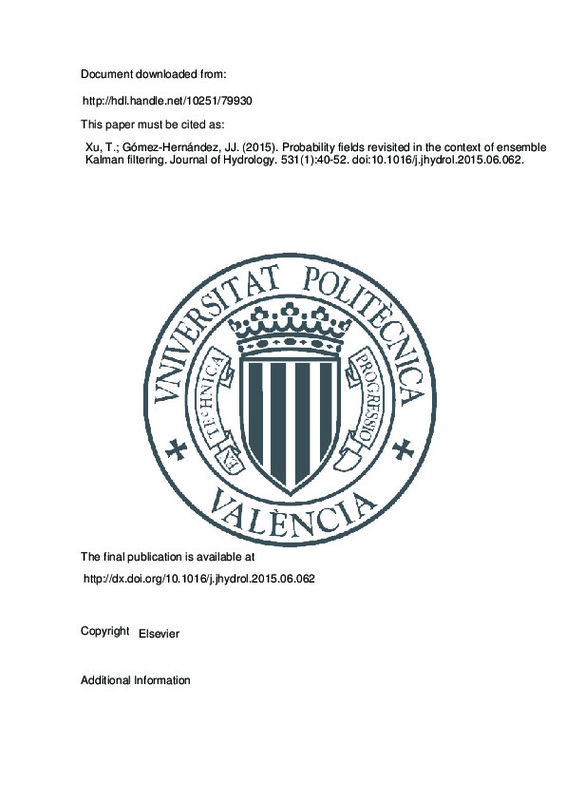JavaScript is disabled for your browser. Some features of this site may not work without it.
Buscar en RiuNet
Listar
Mi cuenta
Estadísticas
Ayuda RiuNet
Admin. UPV
Probability fields revisited in the context of ensemble Kalman filtering
Mostrar el registro sencillo del ítem
Ficheros en el ítem
| dc.contributor.author | Xu, Teng
|
es_ES |
| dc.contributor.author | Gómez-Hernández, J. Jaime
|
es_ES |
| dc.date.accessioned | 2017-04-25T11:20:52Z | |
| dc.date.available | 2017-04-25T11:20:52Z | |
| dc.date.issued | 2015-12 | |
| dc.identifier.issn | 0022-1694 | |
| dc.identifier.uri | http://hdl.handle.net/10251/79930 | |
| dc.description.abstract | Hu et al. (2013) proposed an approach to update complex geological fades models generated by multiple-point geostatistical simulation while keeping geological and statistical consistency. Their approach is based on mapping the fades realization onto the spatially uncorrelated uniform random numbers used by the sequential multiple-point simulation to generate the facies realization itself. The ensemble Kalman filter was then used to update the uniform random number realizations, which were then used to generate a new fades realization by multiple-point simulation. This approach has not a good performance that we attribute to the fact that, being the probabilities random and spatially uncorrelated, their correlation with the state variable (piezometric heads) is very weak, and the Kalman gain is always small. The approach is reminiscent of the probability field simulation, which also maps the conductivity realizations onto a field of uniform random numbers; although the mapping now is done using the local conditional distribution functions built based on a prior statistical model and the conditioning data. Contrary to Hu et al. (2013) approach, this field of uniform random numbers, termed a probability field, displays spatial patterns related to the conductivity spatial patterns, and, therefore, the correlation between probabilities and state variable is as strong as the correlation between conductivities and state variable could be. Similarly to Hu et al. (2013), we propose to use the ensemble Kalman filter to update the probability fields, and show that the existence of this correlation between probability values and state variables provides better results. | es_ES |
| dc.description.sponsorship | The first author acknowledges the financial support from the China Scholarship Council (CSC). Part of this work was done while the second author was on sabbatical with the Kansas Geological Survey, Kansas University, Lawrence, KS, USA, which was funded by the Spanish Ministry of Education, Culture and Sports through grant PRX14/00501. Financial support to carry out this work was also received from the Spanish Ministry of Economy and Competitiveness through project CGL2014-59841-P. | en_EN |
| dc.language | Inglés | es_ES |
| dc.publisher | Elsevier | es_ES |
| dc.relation.ispartof | Journal of Hydrology | es_ES |
| dc.rights | Reserva de todos los derechos | es_ES |
| dc.subject | MPS | es_ES |
| dc.subject | Non-Gaussian | es_ES |
| dc.subject | Sequential simulation | es_ES |
| dc.subject | Inverse modeling | es_ES |
| dc.subject.classification | INGENIERIA HIDRAULICA | es_ES |
| dc.title | Probability fields revisited in the context of ensemble Kalman filtering | es_ES |
| dc.type | Artículo | es_ES |
| dc.identifier.doi | 10.1016/j.jhydrol.2015.06.062 | |
| dc.relation.projectID | info:eu-repo/grantAgreement/MECD//PRX14%2F00501/ES/PRX14%2F00501/ | es_ES |
| dc.relation.projectID | info:eu-repo/grantAgreement/MINECO//CGL2014-59841-P/ES/¿QUIEN HA SIDO?/ | es_ES |
| dc.rights.accessRights | Abierto | es_ES |
| dc.contributor.affiliation | Universitat Politècnica de València. Escuela Técnica Superior de Ingenieros de Caminos, Canales y Puertos - Escola Tècnica Superior d'Enginyers de Camins, Canals i Ports | es_ES |
| dc.contributor.affiliation | Universitat Politècnica de València. Instituto Universitario de Ingeniería del Agua y del Medio Ambiente - Institut Universitari d'Enginyeria de l'Aigua i Medi Ambient | es_ES |
| dc.description.bibliographicCitation | Xu, T.; Gómez-Hernández, JJ. (2015). Probability fields revisited in the context of ensemble Kalman filtering. Journal of Hydrology. 531(1):40-52. https://doi.org/10.1016/j.jhydrol.2015.06.062 | es_ES |
| dc.description.accrualMethod | S | es_ES |
| dc.relation.publisherversion | http://dx.doi.org/10.1016/j.jhydrol.2015.06.062 | es_ES |
| dc.description.upvformatpinicio | 40 | es_ES |
| dc.description.upvformatpfin | 52 | es_ES |
| dc.type.version | info:eu-repo/semantics/publishedVersion | es_ES |
| dc.description.volume | 531 | es_ES |
| dc.description.issue | 1 | es_ES |
| dc.relation.senia | 300564 | es_ES |
| dc.contributor.funder | Ministerio de Educación, Cultura y Deporte | es_ES |
| dc.contributor.funder | Ministerio de Economía y Competitividad | es_ES |
| dc.contributor.funder | China Scholarship Council | es_ES |







![[Cerrado]](/themes/UPV/images/candado.png)

